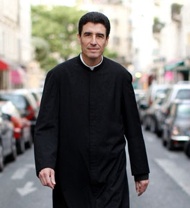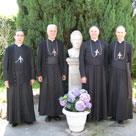Christopher Pearson died on Friday. He was only 61.
I always enjoyed his weekly column in The Weekend Australian. Here’s a memorable article of his; an account (of sorts) of his 1999 conversion to Catholicism.
At the time friends reminded me of how, in 1982, British author Malcolm Muggeridge had described his conversion as “a rat swimming towards a sinking ship”, prompting a telegram from B.A. Santamaria: “Welcome aboard.”
Although Catholicism wasn’t in quite as parlous a condition in 1999, I knew how they felt. The church has often been described as “the barque of Peter” and Benedict XVI wasn’t the first pope to remark that it was storm-tossed and often seemed on the verge of capsizing.
Flannery O’Connor was another writer who was notably unsentimental and ambivalent about an institution she nonetheless accepted as divinely inspired. “I think that the church is the only thing that is going to make the terrible world we are coming to endurable; the only thing that makes the church endurable is that it is somehow the body of Christ and on this we are fed. It seems to be a fact that you have to suffer as much from the church as for it.”
Despite my apprehensions that Catholicism wasn’t going to be a bed of roses, it was clear to me that if I wanted to return to the practice of the faith, there was nowhere else to go. I could never have been happy as a gay Christian – with or without a rainbow sash – because it always seemed to me a contradiction in terms.
There was no getting around the fact the New Testament said we were all meant to be chaste or monogamously married and I had reluctantly concluded that St Paul was right about homosexual sex.
In any case, prudence in the plague years meant I gradually became all but sexually inactive from the mid-1980s and no longer saw much point in defining my identity primarily in terms of sexual preference.
Apart from Rome there was Constantinople, but the rites of the Eastern Orthodox were another, alien world. The Anglican Church I’d known as a teenager had since taken to reinventing fundamental doctrines in conformity with the spirit of the age.
Aside from the fact belief in the resurrection had become optional, Anglicanism was beset by strange, divisive fads.For example, given that a male priesthood had always been a distinctive element of Judaism, preserved in the new covenant by Christ at the Last Supper, ordaining women was ultra vires. In the face of nearly 2000 years of continuous tradition, nothing 80s feminism had to say on the subject could be in the least persuasive. It was perverse and ahistorical to see the theological question of holy orders through the prism of equal opportunity, as some sort of entitlement.
Thirty years before, after reading John Henry Newman’s Apologia Pro Vita Sua at the age of 17, I had begun to doubt the validity of the Church of England’s orders and its claims to continuity as a branch of the universal church. Newman also had mounted a powerful argument that the only way the Reformation churches could sustain their preferred versions of their institutional identity was by systematically ignoring most of ecclesiastical history, especially the more inconvenient aspects of the early church and patristic theology.
Some of my friends said at the time that I must have crossed the Tiber for the sake of beautiful music and ceremony. But as Gerard Manley Hopkins told his family in reply to similar charges, if it had simply been a matter of aesthetic preferences, the Church of England would always have been far more congenial. Hopkins deplored the kitsch that mostly characterised Catholic devotional life in England then. Heaven only knows what he would have made of the banality of the present-day English liturgy.
What I most wanted was not beauty, crucial though it is, but certainty: immutable doctrine and valid sacraments. As an Anglican, the closest I had come to “the peace which passes all understanding” had been through the sacraments: in the confessional and at the altar rail. By my late 40s it felt like time to come back to them.
Making a commitment to regular examination of conscience was unexpectedly therapeutic. It led me to trade in my double bed for something more austere, observe the Lenten fast and try, for the most part, to avoid low bars. I read again the Confessions of my patron saint, Augustine of Hippo, who had famously prayed: “Lord, make me chaste, but not yet”, and knew how he felt.
The welcome I got, especially from people in the Latin mass community, was a warm one. Mostly Irish and working class, its gatherings often involve shucking oysters or shelling prawns, washing them down with Guinness and singing folk noir ballads, as black in their way as Nick Cave’s, about convicts, moonshine and infanticide. The same men and a bunch of their home-schooled children thought nothing of driving 100km each way to sing anthems by William Byrd in an Anglican church at my mother’s funeral last year.
Having come from a cosseted middle-class background and a career in publishing, I had not seen their kind of piety and their respect, bordering on veneration, for the clergy, despite a shared conviction that the church has been going to hell in a handcart since Vatican II. Because the overall standard of preaching in Catholic churches here has been woeful for as long as anyone can remember, the congregation in the churches I frequent tend to tune out during the sermon.
There is another strand, Irish in origin and much less appealing, still heavily represented in contemporary Catholicism. I’m talking about the lace curtain brigade. They tend to a continental form of Puritanism called Jansenism, are obsessively concerned with the sins of the flesh and pride themselves on their instinctual anti-intellectuality and indifference to music. Frances O’Brien, in the ABC TV series The Librarians, epitomises the type.
Still, say what you will about Jansenists, at least they are in no doubt about the reality of evil. Many Catholic clergy don’t seem to take the notion of sin and its consequences seriously any more. I am sick of going to funerals where the deceased are spoken of as though they are already in heaven and have no further need of our intercessions. Typically the celebrant wears white vestments, rather than customary black. The coffin, like a pharaoh’s, is littered with grave goods for the journey – a football scarf, a stubby and reading glasses – rather than a pall. Make no mistake. Father O’Bubblegum, Auberon Waugh’s caricature of trendy clergy of the 80s, is alive and well in the Australian church.
When I converted, as an adherent of the Latin mass I became a member of a minority, as marginalised and persecuted as the first generation of out-and-proud gays. In fact, it was a lot like reliving the 70s. I also got the distinct impression that a number of acquaintances in the hierarchy had been more cordially disposed towards me in my unregenerate middle age. Perhaps they wondered whether it was really necessary for me to make what pastoral care jargon calls “lifestyle sacrifices”. All I can do is quote another of Muggeridge’s paradoxes: “One of old age’s pleasures is giving things up.”
Incidentally, I’m not familiar with Auberon Waugh’s “Father O’Bubblegum,” but if it’s anything like his father’s devastating and funny portrait of “the modern clergyman,” then I’d better remedy that. If only to avoid resemblance with the caricature!






Requiesce in Pace.
This has nothing to do with anything, but I read recently that when Australian-raised cricketer Martin McCague represented England in a Test in 1993, he was described by one journalist as “a rare example of a rat joining a sinking ship”.
The same bloke is reported to have knocked back 72 pints of Guinness over the course of a buck’s weekend in Dublin.